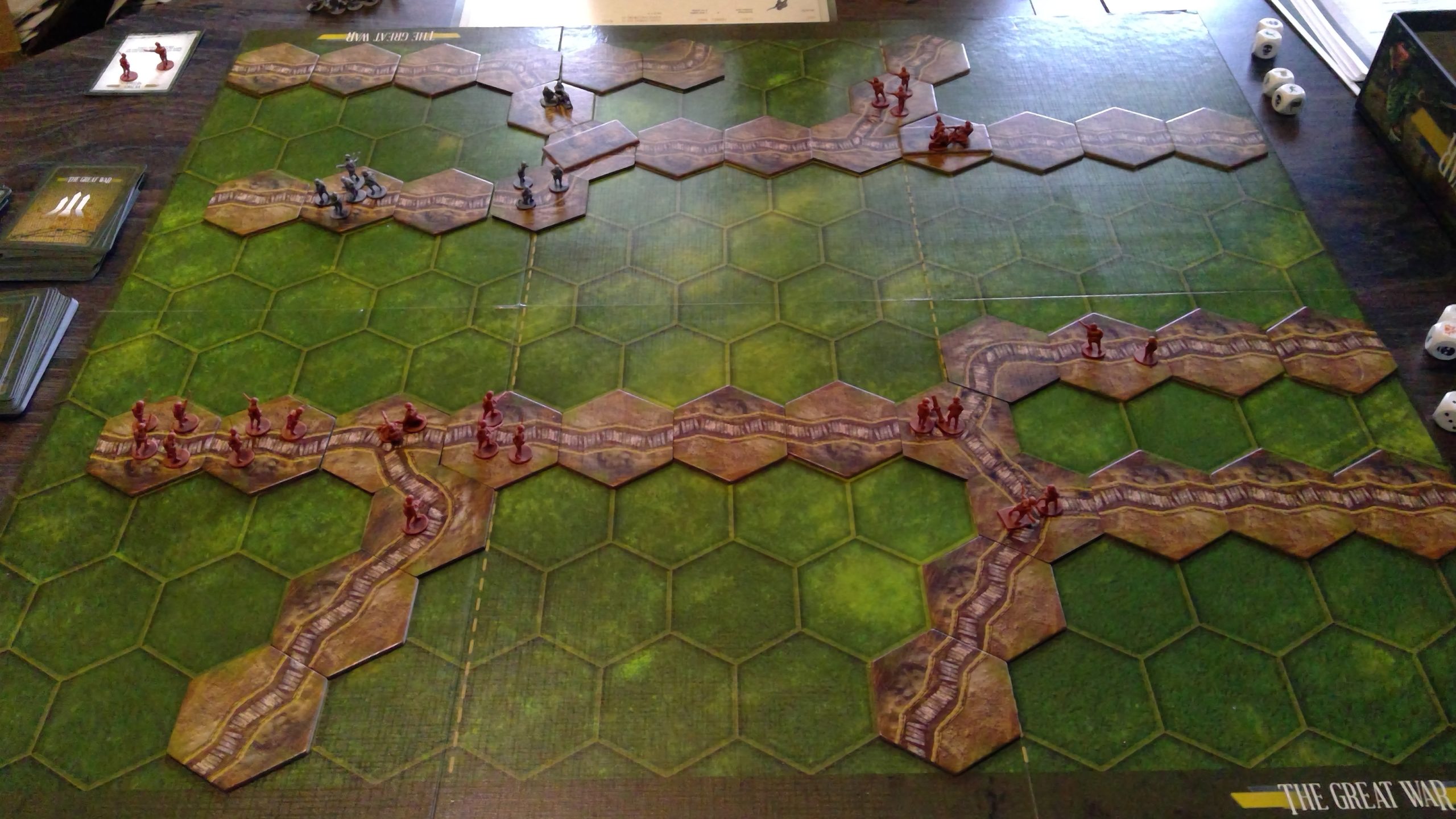Artillery War
Mark was over on March 7th for a round of FtF gaming, now that we’d both recovered from the colds we developed last time. Up this time was The Great War, a Commands & Colors game I’d gotten for Christmas, and finally had prepped.
As my first experience with C&C outside of the GMT games, there were a few things to get used to. First, I’m definitely in favor of the blocks over the minis in this game. They’re not bad, but of course are unpainted, and handling them is a lot more cumbersome than the blocks. The cards were a lot thinner than I’m used to, though it looks like the main deck is just as many cards, and then there’s a secondary ‘attack’ deck. Rules presentation is about comparable, though there was a couple things I wish had made it to the reference card in the same format as in the rules. The board is very well produced, and double-sided (one being a pleasantly verdant field, and the other a churned-up mudscape), though they really really needed to stop that for the half hexes which turn out to be out of play (maybe they plan to have you put two together for epic? but then you only need the half hexes on one side), and the tiles are very thick and solid, and punched out with no trouble.
There’s only a few types of units, so telling the unpainted minis apart generally isn’t an issue. However, Mark missed that he had a German mortar unit, as it didn’t stand out enough from the regular infantry (small problem there: the regular unit is called ‘infantry’ everywhere but the setup instructions, where they’re suddenly ‘rifles’). Really, there’s only three in the base set, plus what’s basically a ‘special unit marker’. The dice are interesting, as there’s ‘burst’, which is the ‘always hit’ result. Two sides of ‘soldier’, which generates one hit no matter how many you get… but terrain protects from them, so it doesn’t do much in a trench. The usual ‘banner’ which causes a unit to retreat (but terrain protects against that as well), a star or ‘HQ’ symbol gives you tokens to be spent (I started calling them ’empty promises from HQ’), and then a ‘skull’, which serves the purpose of the helmet symbol in Ancients: in some cases it’s a hit, but usually it’s a dead side.
The regular deck is about what you’d expect, but you can generally order your OBA as part of one of the section cards, using the HQ tokens to pay for dice. The artillery lands around a designated target hex (chosen by regular d6), but any doubles (or better) also affect the target hex, and the skulls count. Getting three dice ‘on target’ destroys terrain, and negates all protection in the hex. It didn’t happen often for us (twice), but it’s dramatic when it does. And finally, there’s the combat deck, which you spend HQ tokens to use. We didn’t use it much in our game, but I assume we’ll use it more as we get a better idea of what it can do.
We played the non-historical introductory scenario, which took… say three+ hours to do. Now, some of it is relative unfamiliarity, and a desire to keep to the protection of the trenches, but I don’t think it’ll ever match the average 1 hour time of CC:A. That said, it does feel something like western front WWI, which isn’t something I would have said the C&C system can do. I had the Brits, who have more units (and the burden of attack in the second form of the scenario, which we didn’t get to), which I slowly organized for the ‘big push’. Both sides set up nice and comfy in their trench systems, and I moved some reserve up to the front line, while using my mortar and artillery for some effect.
I got the first lucky break of the game, when all four dice on artillery came up ‘4’, and I nearly destroyed a unit along with a hex of trench. I spent some time stockpiling HQ chits and then, two Direct From HQ cards (which allow you to order any unit you care to use a HQ chit on) got me across No Man’s Land, and into the German trench. As expected, the cost of this was a number of wrecked units, but it did finally end with Mark’s left flank wiped out.
…And despite my plan to advance up the trench and start taking on his center with an infantry and machine gun, I had two problems: first, one unit would be in the way of the other, and second, I was completely dry on right flank cards. So, the battle stumbled on for a while longer, without a dramatic conclusion, with more wearing down of our forces (and a triple from me to knock out another trench hex) until I finally won 6-2.
The original plan was to go on to the second version immediately, but that took long enough that there wasn’t really time. We both generally enjoyed it, and we’ll certainly be giving it another try later. We just need to schedule when….


Discussion ¬